

Beat the Heat with Folding Fans
|
Midsummer in Japan is hot and humid. Though many will take the chance to bask under it, the combination of the summer sun and high humidity levels can lead to sweaty, sticky discomfort at best and heat-strokes at worst. One can fight against rising temperatures with icy desserts and air-conditioning, but while on the go, the best way to beat the heat is with a folding fan!
Folding fans, also known as sensu (扇子), are made of accordion-folded washi pasted on to movable strips of wood (usually bamboo). The ends of the wooden strips are connected by a rivet pin, thus allowing these fans to be opened and closed. They are based on uchiwa (うちわ), which had already been in use in all over the world since the dawn of civilisation. They were introduced to Japan via China around the 7th century, afterwhich, Japan adapted and made them foldable in the 8th century. Noblemen always kept a folding fan on them, and soon the ladies of the imperial court followed suit, decorating theirs with elegant paintings. In the beginning, folding fans were reserved only for nobles and monks, and so they were designed and crafted rather simply. As time passed, it became more acceptable for the general public to use folding fans. Beautiful and lightweight folding fans could be pocketed easily, allowing users to carry them around and whip them out whenever needed. This gave rise to a burgeoning industry centred in Kyoto, where the local craftsmen were especially famed for their beautiful and well-crafted fans. Even today, folding fans from Kyoto, known collectively as kyo-sensu (京扇子) are highly-regarded and widely-used throughout the country. There are a lot of steps involved in making a folding fan. Bamboo strips are shaved to a uniform shape, and impurities are removed before holes are drilled into one end. These strips are then soaked to make it easier for them to be shaved. After this, they are dried, polished, and decorated or lacquered. Once the rivet pins are inserted, craftsmen can then glue the washi on. The washi is decorated with a variety of methods and materials. Some craftsmen use stencils and woodblock prints to transfer artwork onto their fans while others hand paint theirs, even affixing precious materials like gold and silver leaves and dust, and gold lacquer to give the fans a gorgeous finish. These finishings make fans a popular Japanese souvenir and gift, to be displayed in one’s home. Besides practical and symbolic uses, folding fans play an important role in traditional Japanese arts like dance, theatre, and tea ceremonies. The shape of an unfolded folding fan is known as suehiro (末広), and is considered a lucky shape in Japanese culture. In the past, many saw its extended shape as a sign of new developments in the future. Indeed, this geometrical design is also often used as an element in kamon (家紋), or family crests. For traditional Japanese dances, performers use specially-made fans with lead weights attached to the rivet pin known as mai-ogi (舞扇). While regular fans are made with 3 sheets of washi, mai-ogi are made with 5-7 sheets of washi. These weights make it easier for performers to move, throw, and spin as part of their routines. Besides tricks, performers can use folding fans to imbue more emotion into their performance. When held in certain ways, folding fans can be used to represent objects like umbrellas and trees, or even actions like flower petals falling. |
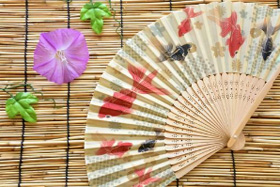 © photoAC 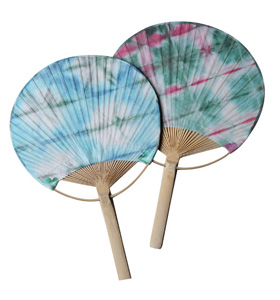 © Natori Kazuhisa, Takahashi Nobuyuki, and pixta 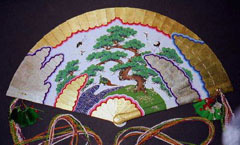 © Kyoto Sensu Uchiwa Shoko Kyodo Kumiai 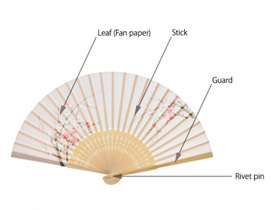 © Web Japan 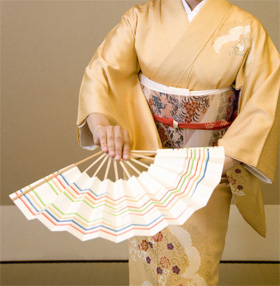 © Web Japan |
|
Theatre performers also use folding fans as props in their performances. In fact, they are an essential prop in rakugo (落語) storytelling performances. Stories are told by just one performer, who relies on their voice, gestures, and two propsーa hand towel and a folding fan. When folded, the fan can represent objects like chopsticks, oars, and fishing rods; when open, they represent letters and torches.
While they are also essential in tea ceremonies, the folding fan is used very differently. Folding fans are not meant to be used to cool oneself, but strictly as ceremonial props. For example, guests use their folding fans when greeting and interacting. Guests place their folding fans between one another to delineate a boundary, and at the same time, create a line of connection between each person. A means to beat the heat, decoration, and artsーit is certainly not difficult to see how pervasive the use of folding fans is in Japanese culture. If you are looking for an elegant way to remain cool (especially in Singapore, where temperatures are warm all year round), why not do so with a folding fan? |
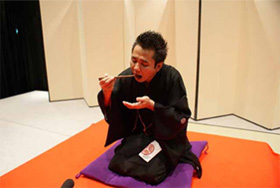 © Mynavi News 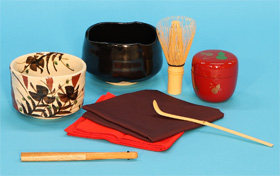 © Web Japan |
Resources
|
Japan Atlas: Kyo-Sensu (Folding Fans). Retrieved 26 July 2021, from https://web-japan.org/atlas/crafts/cra20.html |
|
Japan Creative Centre 4 Nassim Road, Singapore 258372 +65 6737 0434 / jcc@sn.mofa.go.jp https://www.sg.emb-japan.go.jp/JCC/ Nearest parking at Orchard Hotel & Delphi Orchard |
 |